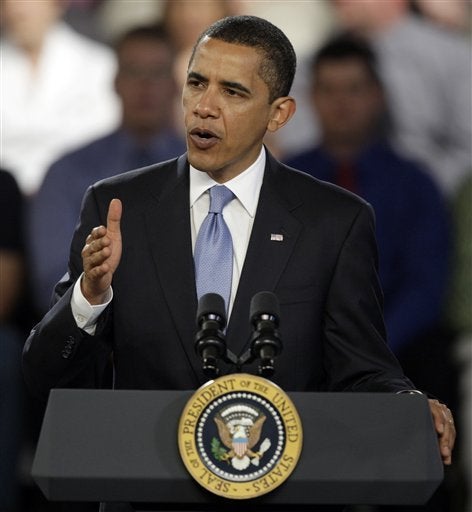
In the movie, "The Incredible Shrinking Man" (1957), the protagonist (played by Grant Williams) sails through a sparkly, radioactive mist which slowly shrinks him down until he's about an inch tall, having to fend off spiders with a straight pin as sword. Obama wants to supply similar pixy dust to the financial sector. As he put it, "Wall Street will remain a big, important part of our economy, just as it was in the '70s and the '80s. It just won't be half of our economy....We don't want every single college grad with mathematical aptitude to become a derivatives trader."
Obama's goal is on the money -- bring finance back into balance as the junior partner to the real economy rather than a bloated and tyrannical lord.
But getting there requires that we understand how finance gobbled up so much of the real economy. The answer involves two basic issues. First, the financial industry is a basket case because it conjured up a whole world of fantasy finance instruments that puffed up their profits while undermining overall economic stability. Second, and at the heart of it all, these conjuring tricks were performed for the purpose of soaking up (and multiplying) the gushing excess of money that -- for more than thirty years -- has been moving out of the hands of middle and lower income families and into the hands of the economic elite.
The prevailing media notion is that the economy got distended due to over-leveraging...meaning that we all borrowed too much money. Sure, consumers ran up too much debt, but that misses the real problem. Who loaned us all that money and where did it come from? Supposedly it came from banks and investment houses that mysteriously borrowed more and more from each other. But how did they get away with that?
The answer is fantasy finance. This massive leveraging didn't just come from borrowing too much. The real leveraging and profiting came from creating new financial instruments (securities) based on nothing at all (meaning you owned no tangible underlying assets.) They created bets, and then borrowed against the bets as if they were real assets, and then borrowed more to make more bets -- all without owning the real thing.
Think for a moment about subprime loans. Right now about $300 billion of them are in, or near, default. That's terrible, but hardly unmanageable and certainly not the stuff of a global meltdown. What created the chaos were those wildly profitable synthetic collateralized debt obligations and similar "structured" financial products, which allowed banks to virtually sell those same subprime loans again and again without owning any of them. It's like selling the Brooklyn Bridge to multiple dupes. Through fancy financial engineering those fantasy products were supposed to have very little risk. Wrong. Instead, when one subprime pool of loans grew shaky, layer after layer of fictitious securities built upon it bit the dust. That's what the Obama administration must regulate into oblivion.
To stop the brain drain we need to do something about the outrageous Wall Street compensation packages that draw so many eager graduates into finance. President Obama suggests that this problem will go away as the sector shrinks - that there will be fewer overcompensated bankers once he comes down hard on fantasy finance through new regulations. But there's more to this problem, and it is symbolized not just by high salaries, but by the growing gap between CEO pay and that of the average working person.
In 1970 the gap between the top 100 CEOs' average pay and the pay of average workers was 45 to 1 ($296,170 to $6,542), reflecting the restraints of lingering New Deal financial controls and mores. As those controls weakened, the gap increased to 127 to 1 by 1980. As deregulation, tax cuts, and the union bashing of the Reagan era took hold, the gap jumped to 321 to 1 by 1990. In 2000, as "financial innovation" pumped up fantasy finance, the ratio of CEO pay to the average workers' pay hit an obscene level of 1,510 to 1. And then by 2006, at the height of the fantasy finance boom, it climbed to a whopping 1,723 to 1 ($50,877,450 to $29,529). The financial sector soaked up trillions of dollars of wealth accumulated by the very rich, while average real wages remained stagnant. (Plug: This data is from new book: The Looting of America (Chelsea Green Publishing, June 2009.)
The pay gap won't go away until we find ways to increase the incomes of the poor and the middle classes ....which is precisely the opposite of what we've done for the past generation. That gap needs a strong dose of incredible shrinking pixy dust in the form of steeply progressive taxes, expanded unionization and a dramatic increase in the minimum wage, which is precisely what happened during our boom years after World War II.
